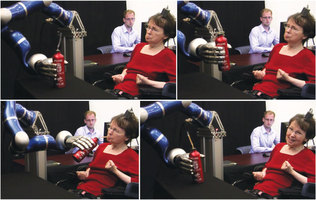Thought Control: Paralyzed Woman Sips Coffee with Brain-Computer Interface and Robotic Arm

It blew my mind back in 2003 when I read that Dr. Miguel Nicolelis at the Duke Center for Neuroengineering had enabled monkeys to control a robot arm with their thoughts.
Nicolelis published his report in the Public Library of Science Biology, which was a smart move. The media attention his study received was significant.
In exchange for sips of juice, monkeys initially used a joystick to control the robot arm. When the joystick was unplugged, the monkeys adjusted to the change, and a computer recorded signals from the monkeys’ brains to simulate the same activity. In other words, the monkeys seemed to understand that their thoughts were guiding the actions of the robotic arm.
What’s the Big Idea?
At the time of Nicolelis’s publication, the hope was that one day people with severe forms of paralysis could use brain-computer interfaces to perform tasks in their everyday lives. That day has now come. A company called BrainGate™ has developed a system that involves the planting of a silicon sensor in a patient’s brain. A team of researchers at Brown University, the Providence VA Medical Center, Harvard Medical School and elsewhere used this sensor to record the thoughts of a paralyzed woman named Cathy Hutchinson who imagined the act of reaching for a bottle filled with coffee. A robotic arm did the rest of the work.
This accomplishment, which was repeated by Hutchinson and another patient in repeated trials, was published in the journal Nature, and is the first published report of “using such technology to manipulate a robot arm to reach for and grab objects.”
Watch this report from Nature Video here:
What’s the Significance?
Researchers hope the BrainGate™ system will be available and affordable for patients within a decade. They have their work cut out for them. For instance, the system is not wireless, and therefore needs to be plugged directly into a patient’s head. And yet, the researchers have broken significant ground, as the Nature journal article reports:
Although robotic reach and grasp actions were not as fast or accurate as those of an able-bodied person, our results demonstrate the feasibility for people with tetraplegia, years after injury to the central nervous system, to recreate useful multidimensional control of complex devices directly from a small sample of neural signals.
What other applications can be envisioned for this research? Nicolelis hopes that one day his research could “enable paralytics to walk using a robotic suit operated by the mind.” And yet, technology will not only be called on to aid those with disabilities, but also enhance people who wish to have more perfect bodies. “Welcome to the brave new world of Machine Beauty,” writes Big Think blogger Dominic Basulto, “where our new willingness to replace our limbs with superior prosthetic devices hints at our technological future as a species.”
Indeed, our future as a species is one in which man and machine are merged as one. As Parag and Ayesha Khanna put it in their forthcoming book, Hybrid Reality: Thriving in the Emerging Human-Technology Civilization, our biological and technological evolution will go hand-in-hand:
Between genetics, neuroscience, synthetic biology and other fields, a systematic effort is underway to break the codes of gene-behavior relations and accelerate our ability to augment ourselves.
This past month, Big Think has been running a series called Humanizing Technology, which asks the broad question of how technology can empower us, not make us more vulnerable. To view other examples of new and emerging technology that accomplishes this, visit the series here.
Follow Daniel Honan on Twitter @Daniel Honan





